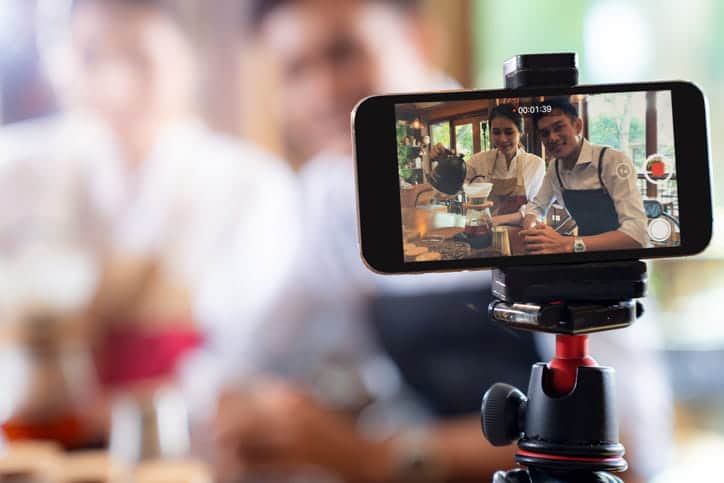Top 15 Strategies To Do Digital Marketing for Restaurants

Digital marketing is becoming a leading approach for restaurants to reach a wider audience, and this is expected to continue growing. With the advancement and prevalence of the digital landscape, a restaurant without an online presence may be missing out on business substantially.
Digital marketing for restaurants allows restaurant owners to put their brand in front of potential customers, engage with them, and make their services easily accessible. Contact us to learn more about online marketing for restaurants.
To help you boost your restaurant’s brand online, here are 15 strategies for digital marketing.
1. Optimize Your Website
Having a website for your restaurant is a great way to have an online presence and reach people who may not ordinarily pass by your location. Customers can also book reservations through your website, which is more convenient than calling the restaurant.
Booking reservations online can also improve a customer’s dining experience, as it makes everything easier. They can easily cancel a reservation as well.
It’s also vital to have an online menu so customers can place an order. The ordering options to consider including on your website are dine-in, delivery, and pickup.
Ensure your restaurant website is mobile-friendly and fast-loading. This makes it convenient for customers to interact with your services at any time, improving user experience. You should also regularly update content, menus, and promotions so your customers have access to current information.
2. Leverage Local SEO
Local search engine optimization (SEO) mainly targets local customers, making it a crucial restaurant digital marketing tool. When a customer searches for restaurants near their location, a list of local restaurants usually appears. It’s important to be on this list, preferably among the top restaurants.
One of the ways to leverage local SEO is by listing your business on Google. Your profile should include your restaurant’s accurate name, address, and phone number (NAP). The Google My Business (GMB) listing helps many local businesses attract the attention of clients, as their profiles appear on both Google searches and maps.
Other details you can include on your profile are business hours, a link to your website, a description of your restaurant, and photos. Ensure you edit your information when anything changes, for instance, when you change your phone number or move to a new location. The accuracy of your NAP details may affect your chances of ranking higher on Google.
Local SEO also entails using local keywords throughout your website, such as the neighborhood and landmarks, and partnering with local businesses to include a link to your website on their platforms.
3. Embrace Social Media Marketing
Another vital digital marketing strategy for restaurants is the use of social media. You need to have accounts on several platforms, including Instagram, Facebook, and TikTok, to reach a wide audience.
In addition to Google and other search engines, many people use social media to find restaurants. When you are active, you are likely to appear among the top searches when a customer looks for restaurants.
You can use social media to share food photos to show potential diners what to expect when they visit the restaurant. Other details you can share with your audience are promotions, events, and awards.
Social media marketing for restaurants allows you to engage with customers. You can use polls to learn more about their preferences, experiences, and interests. Other ways to keep customers engaged are through stories and live polls. Internet marketing for restaurants gives you a more natural way to engage with customers.
4. Content Marketing
Content can help you humanize your brand. Writing blogs is one of the ways content marketing can benefit your restaurant. You should post informative blogs using the right keywords. You can write about recipes, the history of the restaurant, your achievements, a profile on an employee, tips for serving food, customer stories and their experiences, changes you make to your menu, how your business is helping the community, a review of a TV show, movie, or book related to food, and so on.
Videos are also great content for restaurants. For instance, you can post behind-the-scenes glimpses of a chef making food. In addition to writing blogs about upcoming promotions, you can also have promo videos.
Posting interviews with your chefs allows customers to learn more about the people preparing their food and appreciate the effort that happens before their meals get to the table.
5. Invest in Paid Advertising
Paid online advertising allows restaurants to reach a more targeted audience. When you pay for a Google ad, a sponsored link to your website will appear on top of the search results. With paid social media ads, a post on your social media account will appear in the feeds of your target audience, including those who don’t follow you. The content will be labeled “sponsored” or “promoted.”
You need to perform A/B testing for your paid ads. Have two versions of paid ads and compare their performance. The one that performs better should be pushed more. A/B testing allows you to invest in ads that yield the expected results.
6. Partner With Food Influencers
A follower of a blogger or influencer is likely to engage with your restaurant when it’s suggested by them as opposed to you because they have consumed the blogger’s or influencer’s content longer than yours. Therefore, they can trust their recommendation more.
For this reason, consider partnering with food bloggers and influencers. You can ask a blogger to write about your restaurant or list you on their content about top restaurants in your city or neighborhood. Hosting events for food bloggers is another great way to partner with them.
When it comes to food influencers, you can have them visit the restaurant and post content about their experience, or they can review your restaurant. You can also hold events for food influencers.
Take time to find a suitable food blogger and influencer. The factors to consider during your search are how authentic their connection is with their followers, their communication skills, and how they align with your brand (if you are a vegan restaurant, it can be beneficial to work with a blogger or influencer who promotes the vegan lifestyle).
For higher engagement and local reach, consider focusing on micro-influencers (those with 10,000 to 100,000 followers). Due to their small numbers, they are able to create an authentic connection with their followers. Although their numbers are not that high, you can record remarkable conversion rates.
7. Enable Online Ordering
Today, customers appreciate when they can order food from anywhere at any time without visiting a restaurant. That’s why you need to enable online ordering on your website. The lack of such convenience can make a customer click out of your website and find another one.
Another benefit of enabling online ordering is it can reduce the chance of errors. When a customer places an order, they can double-check it before submitting it. Besides, the automated order system will directly take their order and send it to the kitchen, eliminating the chances of miscommunication.
You can partner with third-party apps, like Grubhub or DoorDash. These apps can make your work more manageable, as they can handle food ordering and delivery. You can also get access to many customers who don’t know your restaurant but trust the services of these platforms.
You can also customize the services you receive from these platforms. To save money, you can prioritize direct ordering, which means a customer directly orders food from your website, but a third party delivers it.
8. Encourage Online Reviews
Diners substantially depend on online reviews when choosing a restaurant. Therefore, it’s beneficial to have positive reviews. Customers who have a good experience are more likely to leave a review on your website or platforms, such as Yelp, Google, and TripAdvisor.
Nonetheless, a customer may enjoy dining at your restaurant but forget to write a review. Thus, you should actively remind them to leave online reviews. You can do this through in-person direct requests from your staff, sending an email request, or including a QR code or link to your customer review page on your website or the other platforms on your digital or paper receipts.
When you receive reviews, you should respond to them professionally. Personalize each response using the reviewer’s name, highlight the specifics included in the review, and respond promptly. If a customer leaves a negative review, apologize for their experience and offer a solution. Responding professionally to all reviews can build trust and demonstrate responsiveness.
CTV/OTT Advertising: Reaching Diners on Their Screens
As more consumers shift to streaming platforms like Hulu, Roku, and YouTube TV, Connected TV (CTV) and Over-the-Top (OTT) advertising have become powerful tools for restaurants to reach the right audience. Unlike traditional TV ads, CTV/OTT campaigns offer precise targeting based on location, demographics, and dining preferences, ensuring promotions—whether for seasonal specials, online orders, or reservations—reach potential customers most likely to take action.
These ads are non-skippable, leading to higher engagement and brand recall, while advanced tracking provides clear insights into impressions, website visits, and even foot traffic. With its ability to drive real results, CTV/OTT advertising is a game-changer for restaurant marketing, helping brands stand out in an increasingly digital world.
9. Utilize Email Marketing

Having an email list can be advantageous to your restaurant because email marketing is renowned for increasing engagement, turning one-time customers into regular ones, and facilitating open communication.
The first email you can send a customer is the welcome one once they share their email with you and join your newsletter. Inform them of the benefits of the newsletter, including getting access to specials, new discounts, and other crucial information.
Another email to send customers is the feedback one. After a customer dines at your restaurant or places an order online, you can send them an email reminding them to leave a review.
Additionally, you can encourage repeat orders by showing a customer what else is on the menu. This email can feature photos of the menu and the recommended dishes. Include a button for reordering on this email to make work easier for your customers.
You should send the customers on your email list an email about promotions. Let them know when you have offers or when they have unlocked rewards on the website or app.
It’s critical to segment email lists for tailored offers to repeat customers or special events. For example, customers who unlock rewards in the loyalty program should receive targeted emails.
10. Run Loyalty Programs
Loyalty programs can encourage repeat sales. A customer who is a member of your loyalty program is likely to make more purchases than a non-member because they want to access the benefits of the program, which can be free delivery, early access to offers or products, VIP services, free items, and bonus points that they can redeem to receive discounts or free items.
Offering personalized services to members of your loyalty programs can help improve the customer experience. Through the program, you can interact with the customers, understand their preferences, and, in turn, be in a better position to offer personalized services.
11. Offer Special Discounts and Promotions
Offering time-limited offers (LTOs) can help you attract new customers (especially during holidays) and keep existing ones engaged (a significant percentage of people who have dined at your restaurant are likely to return during an LTO period). To increase visibility, ensure you market your special discounts and promotions on social media and via email.
Examples of the LTOs you can use are free desserts on Friday from 8 p.m. to 10 p.m., a shareable dessert on Valentine’s Day, a discount on a particular meal for a week, special offers on seafood dishes during Lent, and discounts for diners on their birthdays. You can also have a special item on the menu for a limited period.
A successful LTO factors in seasonality, urgency, affordability, and uniqueness.
12. Use High-Quality Visuals
Your restaurant menu should be captured in high-quality photos and videos to make your dishes look enticing. A customer can easily know what’s in a dish when you have clear visuals, which can increase their chances of placing an order.
Photos and videos of food can trigger emotions. A customer can imagine how the food tastes. However, this may not be the case when you post low-quality visuals.
Therefore, you should invest in professional photography and videography to stand out. With high-quality visuals, it can be a given that your restaurant invests in other things as well.
You should also create quality, engaging visual content, such as time-lapse videos of food preparation. A professional can help you set up the cameras and lights at the right angles to get videos that will encourage engagement from viewers.
13. Run Contests and Giveaways
Running contests and giveaways on your social media platforms can increase engagement. Choose a great prize for the winner and give clear instructions for the competition. For example, you can give a gift card to the first 10 people who follow you on social media or leave a review on a particular day. Or you can post a meal and ask your audience to tag a friend for whom they would buy that meal and the reason. The person who provides the best reason can win a free dinner for a week/month, a cooking featuring your signature dishes, or merchandise.
Other contest ideas are asking your audience to name a new item to be included on the menu, posting a photo and asking them to provide a caption, or requesting customers to submit a video recreating a dish using the restaurant’s recipe.
14. Implement Chatbots
Implementing chatbots on your website and social media can help reduce delays considerably. When a customer asks a question, they will receive answers promptly. You can use chatbots to answer questions about reservations, the menu, food allergies, and so on. Furthermore, chatbots can automate reservations and provide menu suggestions.
Chatbots can give your restaurant a competitive advantage, as they can improve customer satisfaction and increase conversions.
15. Focus on Sustainability and Social Causes
Running a restaurant can pollute the environment if you are not careful. Food waste can contribute to landfills and greenhouse gas emissions, single-use plastics, such as plastic bottles and plasticware, can end up in landfills, and the energy consumption in restaurants (cooking, lighting, and refrigeration) can pollute the air.
So, what can you do to protect the environment? For starters, avoid overproduction of food. You can use value-based pricing to encourage customers to order only what they need, provide customers with take-home containers to encourage them to carry leftovers, store food properly, and train employees on how to reduce waste.
You should also consider swapping plastic cutlery for metal ones and encourage customers placing orders online to only ask for cutlery if they need it. Additionally, use energy-efficient bulbs and appliances.
Contributing to social causes, such as partnering with local charities or hosting community events, is another way your restaurant can help the community.
Boost Your Business’s Online Visibility With Levy Online
The above ideas for digital marketing for restaurants can boost your business’s online visibility. Combining multiple digital strategies can give you a maximum impact. You should also regularly assess your plan to identify those performing better and those that should be changed.
Levy Online has a team of experts dedicated to helping restaurants reach their conversion and engagement goals. We help brands connect with their targeted audience online.
Contact our digital marketing agency for restaurants today to boost your online presence.






